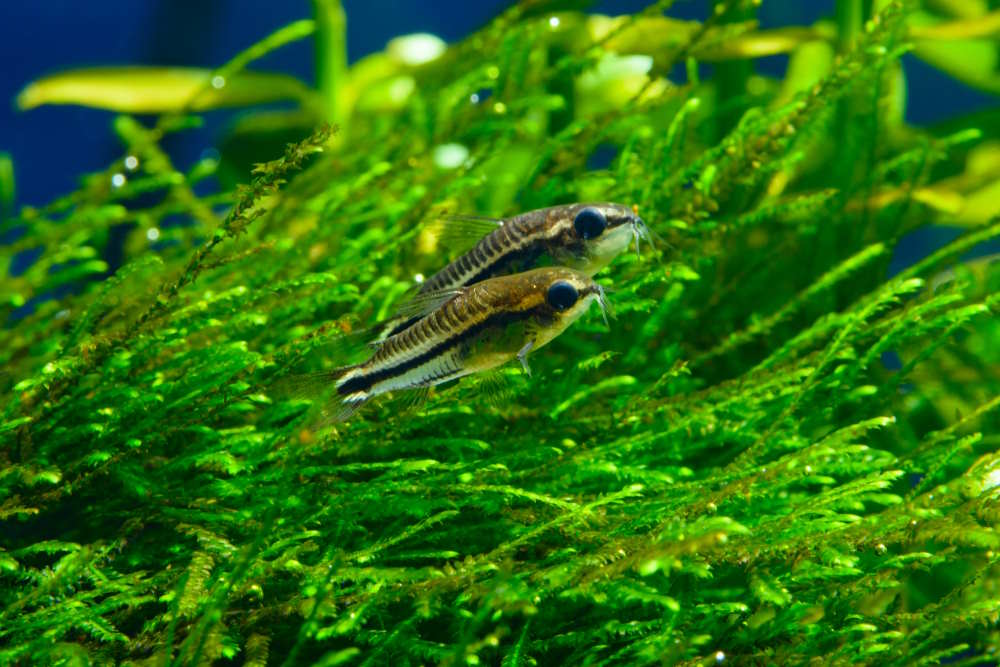Pygmy Coriadorables!
Care Guide for Pygmy Corydoras – The World’s Tiniest Cory Catfish
Cory catfish are beloved in the freshwater aquarium hobby because of their happy-go-lucky nature and interesting behaviors, such as constantly shuffling through the substrate for snacks. While some hobbyists enjoy keeping the larger species, like the hognosed brochis (Corydoras multiradiatus) or emerald cory catfish (C. splendens), nano aquarium enthusiasts take special pleasure in finding the most petite corys. The pygmy cory (C. pygmaeus) has become quite popular because of its adorable appearance and unique swimming style. Learn about what it takes to care for one of the smallest corydoras in the world.

Pygmy cory perched on a plant leaf
What are Pygmy Cory Catfish?
This tiny South American schooling fish grows to a grand total of 1 inch (2.5 cm) in length, with females being slightly rounder and longer than males. Its silvery body with a horizontal, black stripe is not particularly colorful, but it’s hard to resist those big, black eyes and little whiskers that look like a mustache. Like many cory catfish, they like to “wink” by quickly looking down and will dart up to the water surface to take the occasional gulp of air. In contrast though, most corydoras are known as bottom dwellers, whereas pygmy corys have the unusual habit of hovering midwater by flapping their fins, almost like an underwater hummingbird.
What is the difference between the habrosus, hastatus, and pygmy cory? All three of these dwarf corydoras are similar in size and coloration. However, they have clear differences in their patterns that you can easily identify:
- C. habrosus (salt and pepper cory): silvery body with an uneven, horizontal black stripe, a tail covered with stripes, and darker splotches on the head and back
- C. hastatus (tail spot cory): silvery body with a big, black spot at the base of the tail that is flanked by small, white dots
- C. pygmaeus (pygmy cory): silvery body with a thin, horizontal black stripe

Left to right: C. hasbrosus, C. hastatus, and C. pygmaeus
How to Set Up an Aquarium for Pygmy Corys
Pygmy corydoras were originally discovered in the river basins of Brazil, so they are used to pH of 6.4–7.5 and moderately soft water. They also appreciate slightly cooler temperatures between 72–78°F (22–26°C). In the wild, they are prone to predation and therefore like to hide amongst the tree roots and vegetation along the riverbanks. To make them feel more comfortable in your home aquarium, add plenty of plants and hardscape for cover. We often find them perched on anubias leaves and driftwood branches to give them a bird’s eye view of what’s going on in the tank.
How many pygmy corys should be kept together? While a small group could technically fit in a 5-gallon nano tank, they can be a bit shy. Instead, get a 10-gallon or larger aquarium so that you can keep a bigger school of at least 8–12 pygmies that will be less afraid to come out.
What fish can live with pygmy corydoras? Like most cory catfish, pygmy corys are very peaceful community fish that wouldn’t harm a fly. Because they are fairly petite, make sure not to pair them with anything big enough to eat them. Also, they are not the fastest eaters, so don’t let them get outcompeted for food during mealtimes. We find that they do well with other nano species — like neon tetras, chili rasboras, celestial pearl danios, otocinclus, and even a chill betta fish. Also, they won’t bother your snails or adult-sized dwarf shrimp, although they may accidentally slurp up a baby shrimp while foraging.
Pygmy corys swimming midwater with lambchop rasboras
What Do Pygmy Corydoras Eat?
As a species that hangs out in the lower half of the aquarium, they prefer to graze off the ground or on the surfaces of plant leaves. Their little, downturned mouths are most suited for eating sinking foods that are either tiny in size or soft enough to nibble on. For example, frozen bloodworms are often too hefty to easily swallow, but frozen daphnia, cyclops, and baby brine shrimp are perfectly bite-sized. In terms of dry foods, nano pellets, freeze-dried tubifex worm, and sinking wafers are all good options that have worked well for us. One of their favorite foods is Repashy gel food — whenever we drop in a chunk, they all seem to swarm on it like bees to honey.
How to Breed Pygmy Corydoras
While pygmy corys may not be as easy to breed as bronze or albino corys (C. aeneus), many hobbyists have had success with them in home aquariums. Take a mature, 10-gallon tank that is full of plants, mulm, and microfauna for the fry to feed on. Add a colony of at least six corys to increase your chances of having both males and females and feed them well. Be patience because it may take a little while for newly purchased corys to mature if you got them as juveniles. When the female is ready and full of eggs, she is often followed by an entourage of smaller males who are hoping to mate with her.
Unlike other corys that usually lay a cluster of eggs all in the same spot, the female pygmy will deposit a single, sticky egg — about 1 mm in diameter — on a strand of java moss or the roots of floating water sprite. Then she will swim to another location to place the next egg and repeat this process until tens of eggs have been laid. There are varying reports on whether or not the parents tend to eat their own eggs, but just in case, some breeders like to gently remove the eggs with their fingers and place them in a well-aerated spawning container. They may add a few drops of methylene blue, some alder cones, or even dwarf shrimp to clean off any fungal growth.
The eggs start off as translucent white and then eventually change colors. Fertilized eggs become a translucent yellow-tan, whereas unfertilized eggs turn solid white and should be removed to prevent fungus from spreading. Depending on the water temperature, the eggs usually hatch within 2–5 days, and the newborn fry have a translucent body, two black eyes, and a black band behind their head. Within a couple of days, they develop three more black dots down their back, which eventually become a fully mottled pattern all over the body to help with camouflage. Eventually, these splotches combine to form the classic black stripe running their lateral line. This rapid transformation happens within a month or so, such that the juveniles look just like miniature adults and can be hard to tell apart from their parents.
As with most babies of nano species, start off with nearly microscopic foods like vinegar eels, infusoria, and 5–50 micron golden pearls until they’re big enough to eat live baby brine shrimp and Repashy gel food. Provide frequent small meals and frequent small water changes to keep the water quality high.

Pygmy corys love laying their eggs in dense foliage like java moss.
Source: https://www.aquariumcoop.com/blogs/aquarium/pygmy-corydoras





